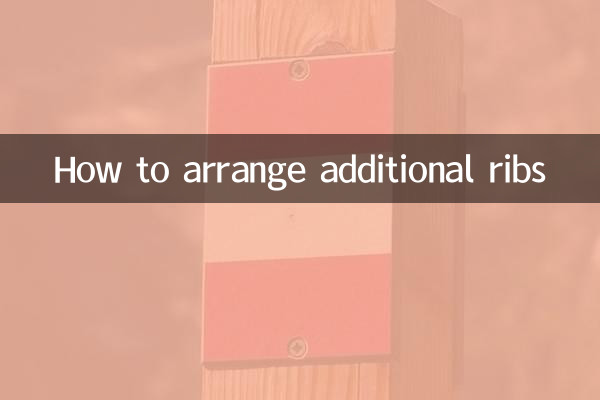How to arrange additional ribs
In construction projects, the arrangement of additional reinforcements is an important link in ensuring structural safety and durability. Additional reinforcement is usually used to strengthen local stress-bearing areas of concrete components, such as beam-column joints, overhangs, or around openings. This article will explain in detail the function of additional reinforcement, layout principles, construction points and common problems, and provide practical reference based on the hot topics and hot content on the Internet in the past 10 days.
1. The function of additional ribs

Additional ribs are mainly used in the following aspects:
| effect | illustrate |
|---|---|
| Enhance local bearing capacity | Add additional reinforcements in areas where stress is concentrated (such as beam-column joints) to prevent cracking or damage. |
| Make up for structural defects | Add steel bars to openings or overhangs to avoid structural failure caused by stress concentration. |
| Improve seismic performance | In earthquake-prone areas, additional reinforcements can enhance the ductility and energy dissipation capacity of components. |
2. Arrangement principles of additional ribs
The following principles should be followed when arranging additional ribs:
| in principle | Specific requirements |
|---|---|
| Symmetrical arrangement | Additional reinforcements should be arranged symmetrically along the direction of stress to avoid eccentric stress. |
| Anchorage length | The anchorage length of additional bars needs to meet the requirements of the specification, usually not less than 15d (d is the diameter of the steel bar). |
| spacing control | The spacing between additional ribs should not be too large, generally no more than 1.5 times the spacing between main ribs. |
3. Construction points of additional reinforcement
The following key points should be noted during the construction process:
| Construction link | Things to note |
|---|---|
| Steel bar tying | Additional reinforcements and main reinforcements should be tied firmly to avoid shifting during pouring of concrete. |
| Protective layer thickness | The thickness of the protective layer of the additional ribs must meet the design requirements to prevent corrosion. |
| Node processing | Additional reinforcements at beam-column joints should be prioritized to ensure force transfer. |
4. Frequently Asked Questions and Solutions
Based on recent hot discussions, the following issues require focus:
| question | solution |
|---|---|
| Additional ribs conflict with main ribs | Adjust the position of additional ribs or use welding connections to avoid cross interference. |
| Insufficient length of additional ribs | Extend the anchoring length as required by the specification, and use mechanical anchoring if necessary. |
| Construction omissions | Strengthen technical explanations and on-site inspections to ensure that additional reinforcements are constructed according to drawings. |
5. Recent hot topics
In the past 10 days, discussions on additional ribs across the Internet have mainly focused on the following aspects:
| topic | heat index |
|---|---|
| BIM technology optimizes additional reinforcement placement | ★★★★☆ |
| Application of new composite material additional ribs | ★★★☆☆ |
| Updated requirements for additional reinforcement in seismic codes | ★★★★★ |
6. Summary
The reasonable arrangement of additional reinforcements is a key link in ensuring the safety of the building structure. Before construction, it is necessary to fully understand the design intention, operate in strict accordance with the specifications, and optimize the layout plan by combining new technologies (such as BIM). Recent hot spots show that seismic resistance specifications and the application of new materials will become the key directions for the development of additional reinforcement technology in the future.
Through the above structural analysis, we hope to provide a clear reference for engineering and technical personnel to ensure the scientificity and reliability of the additional reinforcement layout.

check the details

check the details